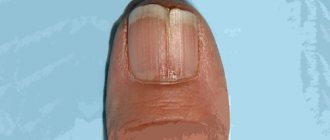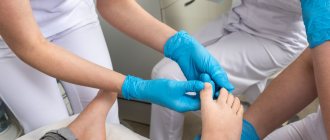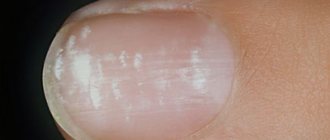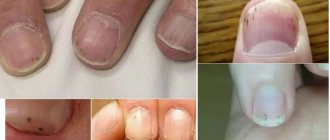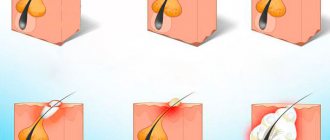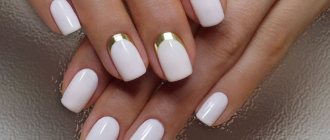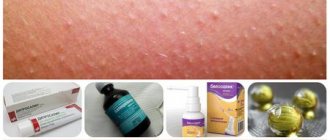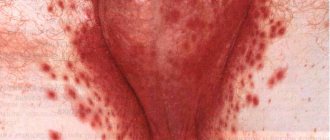Changes in nail color are called onychodyschromia. One of the variants of onychodyschromia is yellowing of the nail plate. It is caused by various reasons: from improper care, the use of decorative varnish, lack of vitamins to diseases of internal organs. Some of them are easy to eliminate on your own, others require treatment from a podologist or dermatologist. Often when nail color changes, other symptoms are present. For example, deformation, thickening, delamination of the plate, appearance of grooves.
Common reasons
Healthy nails are distinguished by a slight shine, smooth surface, and transparency. Their pink color comes from the nail bed, which is visible through the plate.
Common reasons why nails turn yellow on the hands include improper use of decorative varnish, and on the feet - a fungal infection or onychomycosis. But other factors also lead to such changes. Let's take a closer look.
Smoking
Yellowing of the fingertips occurs in heavy smokers, and more often in men. Why do fingernails turn yellow from cigarettes? The fact is that tobacco smoke vapors are absorbed into the top layer of the skin and nail plate, disrupt tissue metabolism, and slow down cell renewal. The longer the smoking period, the more intense the color change.
As a rule, only the nails on the fingers with which a person holds a cigarette turn yellow. Such a cosmetic defect is considered the least of the troubles nicotine brings to our body. Smoking affects the heart, blood vessels, metabolic processes, increases the risk of developing chronic pathologies, and reduces immunity.
Smokers suffer from diseases of the bronchi or lungs, which also affects the color and structure of the nails.
Aging
Why do nails, especially toenails, turn yellow with age? In people over 50 years of age, nail growth and renewal slows down. There are already chronic diseases that lead to impaired blood supply to the lower extremities and nutrition in the area of the nail plate. Elderly people take medications, the list of side effects of which sometimes includes yellowing of the nails.
Thickening, deformation, loss of transparency, and discoloration of the plate in older people are called a special term - senile nail.
Internal illnesses
Chronic pathologies of the liver, gallbladder, and biliary tract are another possible cause of yellowing of nails. Such diseases include chronic inflammatory processes, jaundice, hepatitis, tumors, which lead to an increase in the level of bile pigment bilirubin in the blood. As a result, it accumulates in the subungual space and stains the nail.
Yellow color of nails appears when lymphatic drainage is impaired and blood flow to the extremities is reduced. Retention of lymphatic fluid in the legs, edema, and peripheral circulatory disorders are observed with varicose veins, atherosclerosis, and elephantiasis.
Yellowing of the plate is also caused by pathologies of the endocrine system, including diabetes mellitus, hypothyroidism, and diffuse toxic goiter. With endocrine disorders, metabolic processes in the nail apparatus are disrupted. In addition to yellowing, slow growth of the plate, thickening, crumbling, and delamination are noted.
Decorative coatings
A common reason why women's toenails and fingernails turn yellow is a reaction to decorative varnishes that are applied to the plate without using a base coat or foundation. Yellowing is caused by dark or bright varnishes: red, orange, black, dark blue, dark green. And also cheap or expired.
Why do my fingernails turn yellow after polishing? Onychodischromia under varnish appears as a result of a chemical reaction between the dyes and proteins that make up the plate. If you use nail polish remover with acetone, the chances of yellowing will increase, since the solvent penetrates deeper into the polish.
Why do nails turn yellow under gel polish? This occurs when the gel contains bright pigments, errors in coating, or excessive exposure to a UV lamp.
Not only nails can change color, but also the gel polish or top coat itself. Why does the coating turn yellow? The reason is poor quality composition, violation of the technology for obtaining the product, expiration date or improper care. For example, the color of the coating changes when it comes into contact with household chemicals or coloring compounds.
Nail diseases and injuries
In case of injury, yellow spots form in the area of the free edge of the plate. Such changes cause blows, bruises, pinching. Wearing uncomfortable shoes, shoes with heels higher than 5 cm or narrow toes leads to chronic microtraumas, changes in the shape, structure, and surface of the nail plate.
Among the diseases, onychodyschromia is provoked by:
- Fungal infection. It is 2–3 times more common on the legs of men. Why do nails turn yellow and peel due to fungus? The reason is clouding, thickening of the plate, and accumulation of debris. A nail affected by infection easily crumbles and breaks off;
- Psoriasis. Nails fade, turn yellow, and become brittle. The free edge thickens and peels off. The surface is covered with dotted depressions;
- Onycholysis or detachment of the plate from the bed from the side of the free edge. The separated part of the nail acquires a dull yellow tint and becomes opaque. Onycholysis is caused by trauma, psoriasis, and taking certain medications;
- Onychogryphosis. The nail becomes deformed, becomes very thick, looks like a bird's claw, and becomes dirty gray or yellow-brown. This disorder is a common reason why the toenails of older people thicken and turn yellow;
- Yellow nail syndrome. A rare systemic pathology affecting the fingers and toes. It causes problems with breathing, the lymphatic system, and swelling of the legs. The disease appears accidentally or is inherited.
Use of low-quality coating materials
The most common cause of yellowing is a reaction to the composition of decorative coatings. You can see yellowing after using products with the following components:
- formaldehyde and its derivatives . Formaldehyde is a carcinogenic substance that tends to accumulate in the body and over time affect the structure, color, and integrity of nails;
- toluene affects the functioning of the liver, which, in turn, affects the condition of the nail plates and skin;
- Camphor oil also affects the liver and is a powerful allergen.
Pathogenic microorganisms can develop under a dense layer of coating, especially in the presence of median detachments. Yellowing is often observed in women who systematically wear one covering for more than 4 weeks.
Lyudmila Sheveleva
Doctor, pharmacist
Ask a Question
Perhaps these are the most “harmless” reasons for yellowing nails. Refusal to use such products will allow you to restore the natural color of the plate over time. Of course, if they did not manage to provoke serious liver damage.
Health hazards of gel polish and its components
Other reasons
In addition to the listed diseases, varnishes, age-related changes, and bad habits, yellowing of nails is caused by:
- taking certain medications (tetracycline, quinolone antibiotics, arsenic, carotene, quinolone);
- malnutrition, lack of vitamins and minerals;
- exposure to ultraviolet radiation or the use of self-tanning, when the product gets on the fingers in the cuticle area;
- genetic characteristics, when everyone in the family has nails with a yellow tint;
- drinking coffee and strong black tea in large quantities;
- contact with detergents, cleaning compounds for cleaning or washing dishes without protecting hands with gloves.
Treatment
Treatment of yellowness requires a comprehensive examination. Any home methods are applicable only when the reason lies in:
- vitamin deficiency. At the same time, home and cosmetic products are used as an additional method to taking vitamin complexes;
- consequences of using low-quality coating materials;
- temporary yellowing due to taking antibiotics, smoking, excessive coffee consumption, and so on.
These listed cases are the most common causes of yellowing nails.
In other cases, treatment is required under the supervision of a dermatologist or other specialist, depending on the nature of the disease. In such situations, it is necessary to get rid of the cause, with the cure of which the yellowness will disappear.
- for fungal infections, antifungal drugs are prescribed in the form of tablets (Lamisil, Nizoral), varnishes (Batrafen, Lamisil), solutions (Exoderil);
- for diabetes, specialized medications are prescribed to normalize glucose levels;
- for syphilis - outpatient treatment with injections, droppers and tablets.
If the examination did not reveal any diseases, then try to resort to the help of cosmetic and traditional methods of treating yellowness.
When should you go to a podiatrist?
If the color suddenly begins to change, you cannot ignore the problem. Yellowing of nails can be a temporary cosmetic defect, but can indicate the presence of serious diseases.
To understand the reasons, you need:
- see what decorative varnish or remover you use for manicure or pedicure;
- analyze what shoes you wear;
- remember if there were any nail injuries over the past month;
- remember what new medications you are taking, clarify side effects;
- assess what other changes in well-being have appeared.
If it is difficult to find out and eliminate the causes yourself, go to a podiatrist or dermatologist. The sooner you see a doctor, the faster your nails will recover.
Without special tests, examinations, consultations with specialized specialists, it is impossible to identify serious disorders in the body. We are talking about endocrine disorders, problems with the liver, gall bladder, vascular diseases, and respiratory organs.
The specialist will examine the color, structure of the nail, and changes in shape. Assess the condition of the cuticle, nail folds, bed, skin on the hands and feet.
If necessary, will prescribe:
- general blood analysis;
- blood test for glucose;
- test for thyroid hormones;
- biochemical blood test for liver tests;
- Dopplerography of the vessels of the extremities;
- examination to detect lung diseases.
If the nail plate cracks, crumbles, or smells unpleasant, the doctor will take a sample of the changed nail for microscopic analysis. After all, such symptoms indicate a fungal infection.
Lack of vitamins
Vitamin deficiency is often reflected in the condition of the nails - if they turn yellow, this may indicate a deficiency:
- tocopherol - vitamin E. This vitamin regulates metabolic processes, improves the protective properties of the nail and provides sufficient hydration. To replenish the tocopherol deficiency, add fish, avocado, and spinach to your diet;
- calciferol - vitamin D. You can get it while walking in the fresh air - the vitamin is found in sunlight. Calciferol helps absorb calcium;
- ascorbic acid - vitamin C. Ascorbic acid returns healthy color to nails. Its natural sources are rose hips, black and red currants, bell peppers, parsley, white cabbage;
- biotin – vitamin B7 or H. Activates the body's protective functions, helps in the absorption of B vitamins, and also participates in the production of hemoglobin. There is a lot of biotin in beef liver, kidneys, soy, and also in many nuts.
Vitamins for nails - which ones are needed and how they affect
What to do?
The treatment regimen depends on the cause. When identifying internal diseases, you need to go to specialized doctors: for diabetes, thyroid dysfunction - to an endocrinologist, for liver diseases - to a gastroenterologist, for problems with blood vessels - to a surgeon.
Varnish painting
If the reason is the varnish, the yellowing will go away on its own as the plate grows back. Fans of bright, saturated colors should apply a base coat under the varnish and use varnishes with a safe composition, without formaldehyde. But it is better to choose light, pastel or nude shades.
Wear the covering for no more than 4 - 5 days in a row, then take a break for 2 - 3 days. During this period, treat the plates with nourishing cream or oils, strengthening and restoring medicinal compounds.
If your nails have turned yellow from polish or smoking, but you urgently need to get them in order, try making a bath with lemon juice or hydrogen peroxide to neutralize the unsightly shade.
Lack of vitamins
If a lack of vitamins and minerals is detected, taking vitamin-mineral complexes or supplements will help improve the condition of your nails. The course of treatment lasts from several weeks to months. Specific medications are prescribed by the doctor.
If you are prone to hypovitaminosis, it is important to review your diet. Add more fruits, vegetables, herbs, cottage cheese, vegetable oils. A lack of vitamins affects not only your nails, but also your overall health.
Onychomycosis
Treatment of fungus consists of hardware cleaning of infected areas, taking local or systemic agents that destroy the pathogen. The nail plate grows slowly, so it lasts from 3 to 12 months. It is necessary for the affected nail to be replaced by a healthy one.
In the future, it is important to prevent re-infection. It is necessary to avoid increased humidity of the feet, prolonged contact of hands with water, and do not wear someone else’s shoes. Wear protective rubber slippers when visiting public showers, swimming pools, saunas, baths, and the beach.
Nail psoriasis
Psoriasis is a chronic pathology, from which it is still impossible to get rid of it forever. Its characteristic feature is red, scaly spots on the surface of the skin. The goals of therapy are to cope with exacerbations, prolong the period of remission, and improve the quality of life of patients. A dermatologist treats the disease.
Depending on the severity of the condition, the following is prescribed:
- agents that relieve inflammation;
- retinoids that suppress excess cell growth;
- immunosuppressants;
- vitamins;
- drugs that improve the condition of the skin and nails.
To prevent exacerbations of psoriasis, proper care is important, as well as the elimination of provoking factors. The latter include injury, stress, infection, exposure to the sun, cold or dry air.
Symptom of yellow nails
Yellow nails are rarely an independent disease and are usually accompanied by a number of additional manifestations:
- changes in the structure of the nail plate - thickening, thinning, roughness, fragility;
- growth slowdown;
- inflammation of the side ridges;
- signs of an allergic reaction - redness of the periungual ridges, their inflammatory swelling, small rash, itching;
- deterioration of health in the form of dizziness, migraines, loss of strength.
The intensity of these signs directly depends on the causes of yellowing.
Prevention
It is easier to prevent the problem than to select ways to restore the healthy color of the plates.
You can prevent the appearance of yellowness after using decorative coatings (varnish, shellac, etc.) by choosing the right products for nail art. Preference should be given to products labeled: “Big 5 free” or “Big 3 free”. Even when using regular varnish, you need to use a base coat. The base will prevent the penetration of pigment and toxins into the nail structure.
After removing the old layer of varnish, you should take a break to restore the nail structure. Don’t forget about health masks for women’s hands.
Timely consultation with a doctor at the slightest suspicion of a disease of internal organs or systems. This is especially true for pathologies associated with the liver and cardiovascular diseases.
Cosmetical tools
Brigitte Bottier, Repairing Polish for Yellow Nails
A transparent varnish for masking yellowness, which applies as a thin film. Due to the presence of algae extract, calcium and vitamin E, it takes care of nails, normalizes air exchange and eliminates yellowness if it is not caused by internal reasons.
Essence, Whitening polish
The brightening effect is achieved by including natural lemon extract in the composition. Can be used as a base coat for cosmetic varnish, in this case it also acts as a product that protects the nail plate from pigmentation.
Frenchi Smart Enamel Nail Whitener
The active bleaching agent is lime extract. Contains a UV filter to prevent the penetration of ultraviolet rays. Apply in 2 layers as a stand-alone product and in 1 as a base for colored varnish.
Orly, Nail Whitener
Dissolve the bleach in water and then soak in the bath for 5 minutes. Contains citric acid and tea tree oil. After the bath, it is recommended to apply a base coat or clear varnish to prolong the effect of the drug.
If the yellowness is located under the nail plates
If it turns yellow under the nails, this most likely indicates a pathology of one of the internal organs. It could be:
- Jaundice, the causes of which are diseases: liver (hepatitis, cirrhosis, liver cancer or metastases to this organ),
- biliary tract (cholelithiasis, tumor of the papilla of Vater),
- vessels supplying the bile ducts and liver
- erythrocytes, in which their increased breakdown occurs in the vessels.
This group of diseases is characterized by yellowing of the skin, the appearance of yellow coloration of the sclera, drowsiness, nausea, there may be bitterness in the mouth (if the cause is in the bile ducts), loss of appetite, and changes in the color of feces and urine.
Preventive measures
- When performing a traditional manicure procedure, you must always follow simple hygiene rules. And before applying decorative varnish, use a base.
- Periodically use antifungal creams and healing baths.
- If you still smoke, you should get rid of this habit. It is better to enjoy dark chocolate and your favorite fruits.
- Of course, it’s simply impossible to create your favorite manicure without polish, but don’t forget about the health of your nails by leaving them unpainted every four days.
It should be noted that even nail experts recommend not to overload your nails with decorative products and not to paint your nails at all for at least a few days a month. After all, this is the only way the nail plate can breathe freely and recover naturally.
- In addition to these recommendations, do not forget to wear special gloves when cleaning.
As a result, we can safely say that if your nails have acquired a yellowish tint, you should not be upset. After all, thanks to simple treatment methods, you can quickly get rid of this non-aesthetic ailment, and following simple preventive measures will help you never encounter yellow marigolds.
Home Remedies
To whiten nails at home, use baths, masks and lotions based on:
- lemon and citric acid;
- toothpaste;
- hydrogen peroxide;
- vinegar;
- soda;
- essential oils.
Baking soda
You can use soda in two formats - as an independent product or as one of the components of the bath.
- for a bath - add 1 tsp to 1 liter of warm water. soda and lower the brushes for 10-15 minutes. The bath has a whitening effect and also strengthens nails. Monitor the temperature of the liquid - it should not be too cold, but not scalding - from 37° to 40°C.
- To whiten with soda, take a soft brush, for example, an unnecessary toothbrush, moisten it with water and pick up a small amount of soda. Gently brush the nail plate for no longer than 30 seconds per nail. After completing the procedure, wash off the remaining soda with warm water and lubricate your hands with cream.
Baking soda can be used once a week for as long as necessary until complete whitening occurs.
Lemon lotion
- Squeeze the juice from half a lemon;
- Soak a cotton pad with the juice and rub the juice into each nail;
- Leave for 15 minutes. then add warm water.
Do not use lemon juice if you have inflamed hangnails, wounds or abrasions - lemon juice irritates the skin and causes discomfort.
Toothpaste mask
- 1 tsp. Mix whitening toothpaste with 1 tsp. baking soda and stir;
- Apply the resulting mixture to your nails and leave for 15 minutes;
- Rinse off any residue by rubbing or using a soft brush.
Express mask with peroxide
- Mix hydrogen peroxide with water in a ratio of 1 to 2 - per 1 tsp. peroxide, 2 tsp. water;
- Add 2 tsp. toothpaste and wait until it stops foaming;
- Apply the mixture for 1-2 minutes, then rinse with warm water using massaging movements.
Vinegar bath
- In 1 l. add 1 tbsp warm water. l. vinegar 70%;
- Immerse your fingertips in the bath for 10-15 minutes;
- Rinse your hands well under warm running water, wipe dry and apply cream.
Hand baths: 30 recipes for different purposes
Salt bath
- Dissolve 1 tbsp in 1 liter of water. l. sea salt;
- Add 2-3 drops of tea tree oil to the bath and soak the brushes for 10 minutes;
- Rinse off the remaining salt, then moisturize the skin with cream.
Mask with oils
- 1 tbsp. l. Mix lemon with ylang-ylang and jojoba oil. 1-2 drops of each oil will be enough;
- Apply the mixture to your nails with a cotton pad and leave for 5-7 minutes;
- There is no need to rinse off the composition - just wipe your fingertips with a dry cloth.
All these recipes only mask the problem, but do not treat the cause if it lies in a disease or other pathology. The disappearance of yellowness does not always indicate recovery, so try to maintain your health and get checked regularly.
A guide to diseases and problems with nails: diagnosis, causes and remedies for 12 diseases
